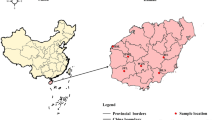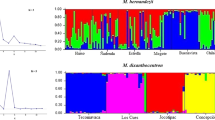Summary
An expedition to Chile and Argentina was made with the main purpose of collecting representative samples of the genetic variability of the speciesHordeum chilense Roem. et Schult. During the field trips 55 populations ofH. chilense and 45 populations of otherHordeum species were collected. The habitats where the species were growing were analyzed.
Similar content being viewed by others
References
Bothmer, R. von & N. Jacobsen, 1985. Origin, Taxonomy, and Related Species. Barley, Agronomy Monograph 26: 19–56.
Bothmer, R. von, N. Jacobsen, C. Baden, R. B. Jorgensen & I. Linde-Laursen, 1991. An ecogeographical study of the genusHordeum. Systematic and Ecogeographic Studies on Crop Genepools 7. International Board for Plant Genetic Resources. Rome, Italy.
Bothmer, R. von, N. Jacobsen & E. Nicora, 1980. Revision ofHordeum sect.Anisolepis Nevski. Bot. Notiser 133: 539–554.
Cabrera, A. & A. Martín, 1991. Cytology and morphology of the amphiploid Hordeum chilense (4×) ×Aegilops squarrosa (4×). Theoretical and Applied Genetics 81: 758–760.
Cubero, J. I., A. Martín, T. Millán, A. Gómez-Cabrera & A. de Haro, 1986. Tritordeum: a new alloploid of potential importance as a protein source crop. Crop Science 26:1186–1190.
Dyksterhuis, E. J., 1958. Range conservation based on sites and condition classes. Journal of Soil and Water Conservation 13: 104–115.
Fedak, G., 1992. Perspectives on wide crossing in barley. In: L. Munch, K. Kirkegaard & B. Jensen (Eds), Barley Genetics VI, volume II, pp. 683–699. The Organizing Committee of the Nordic Countries. Sixth International Barley Genetics Symposium. Helsingborg, Sweden.
Fernández, J. A., 1989. Genetics ofHordeum chilense. Current status. Plant Breeding 102: 10–16.
Gallardo, S. & J. Gastó, 1985. Sistema de Clasificación de Pastizales. Sistemas en Agricultura. IISA 8714. Departamento de Zootecnia. Facultad de Agronomy. Pontificia Universidad Catolica de Chile. Santiago, Chile.
Gastó, J., F. Silva & F. Cosio, 1990. Sistemas de Clasificación de Ecorregiones Andinas de Sudamérica: Reinos, Dominios y Provincias. Red de Pastizales Andinos (REPAAN), Departamento de Zootecnia. Pontificia Universidad Catfilica de Chile. Santiago, Chile.
Köppen, W. 1923. Die Klimate der Erde, Grundriß der Klimakunde. De Gruyter. Leipzig, Germany.
Martín A., 1988. Tritordeum: the first ten years. Rachis 7: 12–15.
Martín, A. & J. I. Cubero, 1981. The use ofHordeum chilense in cereal breeding. Cereal Research Communications 9: 317–323.
Martín, A. & V. Chapman, 1977. A hybrid betweenHordeum chilense andTriticum aestivum. Cereal Research Communications 5: 365–368.
Martín, A. & E. Sanchez-Monge, 1982. Cytology and morphology of the amphiploidHordeum chilense ×Triticum turgidum conv.durum. Euphytica 31: 261–267.
Panario, D., E. Morató, S. Gallardo & J. Gastó, 1988. Sitio en et Sistema de Clasificación de Pastizales. Informe CONICYT-FONDECYT. 1409-86. Santiago. Chile.
Person-Dedryver, F., J. Jahier & T. E. Miller, 1990. Assessing the resistance to cereal root-knot nematode,Meloidogyne naasi, in a wheat line with the added chromosome arm 1HchS ofHordeum chilense. Journal of Genetics and Breeding 44: 291–296.
Valderrama, X., F. Cosio, J. Gastó & M. Castro, 1991. Caracterización y reproducción de especies pratenses nativas y/o naturalizadasBromus unioloides H.B.K. yHordeum chilense Brongb., del dominio seco-estival de Chile como banco de germoplasma para la regeneración de ecosistemas degradados. Dpto. de Ganadería y Pastizales. Facultad de Agronomía. Universidad Católica de Valparaíso. Quillota, Chile.
Author information
Authors and Affiliations
Rights and permissions
About this article
Cite this article
Tobes, N., Ballesteros, J., Martínez, C. et al. Collection mission ofH. chilense Roem. et Schult. in Chile and Argentina. Genet Resour Crop Evol 42, 211–216 (1995). https://doi.org/10.1007/BF02431254
Received:
Accepted:
Issue Date:
DOI: https://doi.org/10.1007/BF02431254




